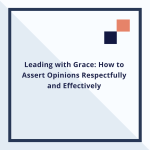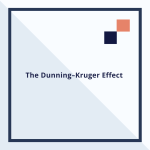The Dunning–Kruger Effect is a psychological concept with significant implications for leadership and business, making it an essential topic for modern leaders to understand. Discovered by researchers David Dunning and Justin Kruger in 1999, this phenomenon describes the tendency of individuals with limited competence to overestimate their abilities. Conversely, those who are more skilled often underestimate their own expertise. In the business context, understanding the Dunning–Kruger Effect can be pivotal for enhancing workplace dynamics and fostering effective leadership.
How the Dunning–Kruger Effect Works
The principle behind the effect is straightforward: the less knowledge and experience a person has in a given area, the more confident they are in their self-assessment. These individuals often lack the skills necessary to evaluate their performance accurately, leading to unjustified confidence. On the other hand, experts have a clearer understanding of the limitations of their knowledge, making them more humble and cautious in their self-evaluations.
The Dunning–Kruger Effect in the Business World
This cognitive bias frequently manifests in workplace settings, often resulting in poor decision-making or ineffective management. Here are some examples of how this effect can impact organizations:
1. Hiring Practices : Unqualified candidates may present themselves with excessive confidence, influencing hiring decisions. Human resources teams must know this effect to avoid hiring the wrong people.
2. Leadership Challenges : The Dunning–Kruger Effect can lead to unqualified leaders occupying senior roles, negatively impacting team performance. These leaders may make misguided decisions or ignore valuable input from their advisors.
3. Performance Assessments : Some employees may overrate their performance, complicating efforts to improve overall productivity. Managers need to identify these gaps between perceived and actual performance.
Strategies to Mitigate the Dunning–Kruger Effect
To minimize the negative impact of this phenomenon, leaders can implement several strategies to promote a more effective and continuously learning work environment:
1. Objective Evaluation : Rely on data-driven performance metrics rather than subjective impressions. Regularly measuring performance helps identify discrepancies between perceived and actual competence.
2. Constructive Feedback: Providing consistent, constructive feedback helps employees understand their strengths and areas for improvement. It is crucial to deliver feedback that encourages growth and development.
3. Employee Education : Encourage professional development through workshops and training programs. As employees become more aware of their knowledge gaps, the effects of the Dunning–Kruger bias are reduced.
4. Fostering a Learning Culture : Promote a work environment that values continuous learning and views mistakes as opportunities for growth. When employees realize the importance of self-improvement, they become more open to acknowledging their limitations.
The Leader’s Role in Addressing the Effect
Leaders must recognize that the Dunning–Kruger Effect is not a rare occurrence but a natural part of human behavior. Therefore, they should be prepared to address these challenges proactively. By providing resources for skill development and offering mentorship, leaders can empower employees to better understand their capabilities.
Conclusion
The Dunning–Kruger Effect presents an ongoing challenge in leadership and organizational management. However, with thoughtful strategies and intentional practices, leaders can mitigate its impact. Promoting self-awareness and fostering a culture of continuous learning can make a significant difference in individual and team performance. Understanding this cognitive bias is crucial for developing resilient and high-functioning teams.







